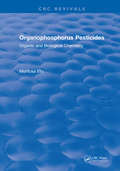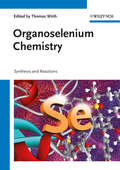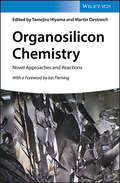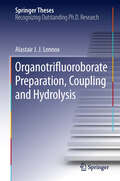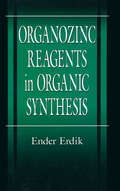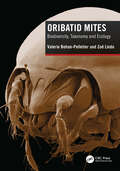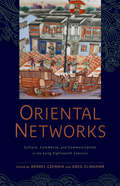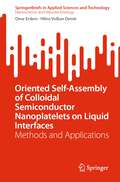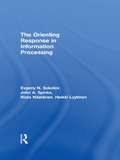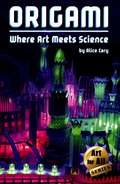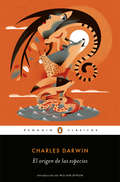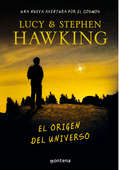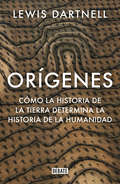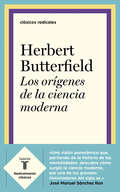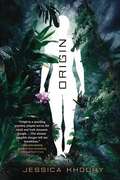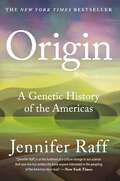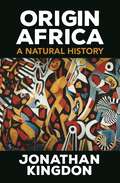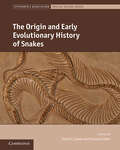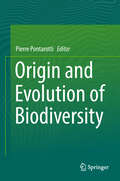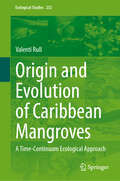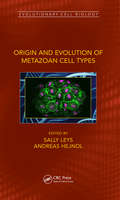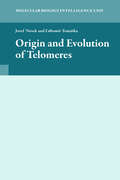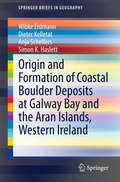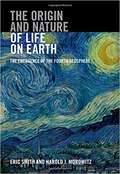- Table View
- List View
Organophosphorus Pesticides
by Morifusa EtoIn order to get a general concept of organophosphorus pesticides with such a variety in structure and biological activities, consideration of each aspect of chemistry, biochemistry, and the applied sciences is necessary. This book consists of these three main parts. After the presentation of the background of phosphorus chemistry in Chapter 1, stress was put on the chemical and biochemical reactions of organophosphorus pesticides, including synthesis, analysis, metabolism mode of action, and other interesting aspects in Chapter 2 to 4, and on the structure-pesticidal activity relationship in Chapter 5.
Organoselenium Chemistry
by Thomas WirthSelenium-based methods in synthetic chemistry have developed rapidly over the past years and are now offering highly useful tools for organic synthesis. Filling the gap for a comprehensive handbook and ready reference, this book covers all modern developments withinthe field, including biochemical aspects. The chemistry chapters are organized according to the different reactivities of various seleniumcompounds and reagents, with each chapter dealing with a special reaction type. Also includes a table with 77Se NMR shifts to aid in practical problems.From the Contents:* Electrophilic and Nucleophilic Selenium* Selenium Compounds in Radical Reactions* Selenium-Stabilized Carbanions* Selenium Compounds with Valency Higher than Two* Selenocarbonyls* Selenoxide Elimination and [2,3]-Sigmatropic Rearrangement* Selenium Compounds as Ligands and Catalysts* Biological and Biochemical Aspects of Selenium Compounds
Organosilicon Chemistry: Novel Approaches and Reactions
by Tamejiro Hiyama Martin OestreichProvides a unique summary of important catalytic reactions in the presence of silicon A must-have for all synthetic chemists, this book summarizes all of the important developments in the application of organosilicon compounds in organic synthesis and catalysis. Edited by two world leaders in the field, it describes different approaches and covers a broad range of reactions, e.g. catalytic generation of silicon nucleophiles, Si-H Bond activation, C-H bond silylation, silicon-based cross-coupling reactions, and hydrosilylation in the presence of earth-abundant metals. In addition to the topics covered above, Organosilicon Chemistry: Novel Approaches and Reactions features chapters that look at Lewis base activation of silicon Lewis acids, silylenes as ligands in catalysis, and chiral silicon molecules. -The first book about this topic in decades, covering a broad range of reactions -Covers new approaches and novel catalyst systems that have been developed in recent years -Written by well-known, international experts in the areas of organometallic silicon chemistry and organosilicon cross-coupling reactions Organosilicon Chemistry: Novel Approaches and Reactions is an indispensable source of information for synthetic chemists in academia and industry, working in the field of organic synthesis, catalysis, and main-group chemistry.
Organotrifluoroborate Preparation, Coupling and Hydrolysis
by Alastair J. LennoxAlistair Lennox's thesis reports on the reactivity of organotrifluoroborates, which are becoming increasingly important reagents in synthesis. The thesis is divided into three sections. The first section describes a method for preparing organotrifluoroborates. The second section reports on a mechanistic investigation into the main application of RBF3K reagents as coupling partners in Suzuki-Miyaura coupling, phenomena identified as arising from organotrifluoroborate hydrolysis and fluoride release. The final section reports on a detailed investigation into the hydrolysis mechanism, a prerequisite for their Suzuki-Miyaura coupling, and how it may be predicted and controlled. This research has uncovered many interesting and useful details and shows how problems associated with Suzuki-Miyaura coupling can best be addressed. There has already been wide industrial uptake of the new procedures and insights. The broad nature and clear and succinct style will make the thesis a valuable resource for anyone working in synthesis, organometallic chemistry, or in homogeneous catalysis.
Organozinc Reagents in Organic Synthesis (New Directions In Organic And Biological Chemistry Ser. #9)
by Ender ErdikOrganozinc reagents are used extensively in organic synthesis to find useful pathways to organic products. Illustrated and tabulated with over 950 equations, schemes, tables, and figures, Organozinc Reagents in Organic Synthesis provides an overall picture of the chemistry of organozinc compounds. Written by a professor of organic chemistry, the book familiarizes the reader with the reactions involving organozinc reagents that have general usefulness in synthesis. Emphasis is placed on preparation methods and reactivity of organozinc reagents. Reactions are summarized in equations and schemes, making it easy for you to see the characteristics of each type of reaction.
Oribatid Mites: Biodiversity, Taxonomy and Ecology
by Valerie Behan-Pelletier Zoë LindoOribatid mites, also called beetle or moss mites, include more than 10,000 named species representing 172 families worldwide. This book provides an identification key to the 96 families, 250 genera and the c.580 described species for Canada and Alaska, a fauna that encompasses more than 50% of Northern Hemisphere genera. It includes known data on the ecology of species, their distribution in the Holarctic region, and relevant literature. Oribatid mites are model arthropods in studies on development, morphology, ecology, physiology, and biomechanics. Growing recognition of the importance of soil systems for agriculture, reclamation, carbon storage and climate mitigation has spurred recent interest in the vast soil biodiversity that provide these ecosystem services. Yet the major barrier to exploring and understanding soil biodiversity is lack of comprehensive and functional taxonomic and ecological treatments of key biotic groups; groups such as the oribatid mites. Oribatid Mites is unparalleled in the comprehensive nature of the information provided. The authors, two leading global experts for this group, hope that readers will come to share their understanding of oribatid mites as part of the charismatic microfauna, the imagery in this book conveying their unique beauty.
Oriental Networks: Culture, Commerce, and Communication in the Long Eighteenth Century (Aperçus: Histories Texts Cultures)
by Bärbel Czennia Greg Clingham Richard Coulton Stephanie Howard-Smith Samara Anne Cahill Jennifer L. Hargrave James Watt Kevin L. CopeOriental Networks explores forms of interconnectedness between Western and Eastern hemispheres during the long eighteenth century, a period of improving transportation technology, expansion of intercultural contacts, and the emergence of a global economy. In eight case studies and a substantial introduction, the volume examines relationships between individuals and institutions, precursors to modern networks that engaged in forms of intercultural exchange. Addressing the exchange of cultural commodities (plants, animals, and artifacts), cultural practices and ideas, the roles of ambassadors and interlopers, and the literary and artistic representation of networks, networkers, and networking, contributors discuss the effects on people previously separated by vast geographical and cultural distance. Rather than idealizing networks as inherently superior to other forms of organization, Oriental Networks also considers Enlightenment expressions of resistance to networking that inform modern skepticism toward the concept of the global network and its politics. In doing so the volume contributes to the increasingly global understanding of culture and communication. Published by Bucknell University Press. Distributed worldwide by Rutgers University Press.
Oriented Self-Assembly of Colloidal Semiconductor Nanoplatelets on Liquid Interfaces: Methods and Applications (SpringerBriefs in Applied Sciences and Technology)
by Onur Erdem Hilmi Volkan DemirThis book highlights the fabrication of orientation-controlled colloidal quantum well (nanoplatelet) thin films using liquid interface self-assembly. The book details methods for orientation-controlled deposition of CdSe core nanoplatelets for characterization of directional energy transfer in nanoplatelets and layer-by-layer construction of CdSe/CdZnS core/shell nanoplatelets to create optically active waveguides with precisely tunable thickness and excellent uniformity across device scale. It also provides a future outlook for construction of large-scale two- and three-dimensional nanoplatelet superstructures and their incorporation into device fabrication.
The Orienting Response in Information Processing
by Heikki Lyytinen Risto Naatanen Evgeni N. Sokolov John SpinksThis book is a testimony to Evgeny Nikolaevich Sokolov's years of work in developing knowledge in the areas of perception, information processing and attention, and to the research it has spawned. It presents a historical account of a research program, leading the reader toward a cognitive science approach to the study of perception and attention. An understanding of neuroscience and mathematical modeling are helpful prerequisites. The co-authors collected data on orienting, attention, and information processing in the brain using single-cell recordings, central, autonomic, cognitive, behavioral, and verbal measures. This commonality brought them together for a series of meetings which resulted in the production of this book. The book ends with a review of some of the co-authors studies that have developed from or in parallel with Sokolov's research. They investigate, in particular, the concepts of attention and anticipation using a psychophysiological methodology.
Origami: Where Art Meets Science (Fountas & Pinnell LLI Purple #Level V)
by Alice CaryOrigami: Where Art Meets Science by Alice Cary
El origen de las especies (Ciencia Y Tecnología Ser. #Vol. 2512)
by Charles DarwinLa obra que revolucionó nuestra visión de la evolución. Charles Darwin invirtió más de dos décadas en escribir El origen de las especies, la obra que marcó uno de los puntos de inflexión más importantes del pensamiento científico. A lo largo de estas páginas, Darwin expone su teoría de la selección natural y defiende que las especies no fueron creadas por una mano divina, sino que primero existieron unas formas más simples que a lo largo del tiempo fueron mutando y evolucionando para adaptarse al medio. Se podría afirmar que sus ideas siguen creando controversia incluso en la actualidad. Sin lugar a dudas, El origen de las especies es el libro más influyente de la historia natural y, por lo tanto, una obra fundamental en la historia de la humanidad. La presente edición viene acompañada de una esclarecedora introducción y una cronología de la mano de William Bynum, catedrático emérito de la University College de Londres y reconocido experto en historia de la medicina y de las ciencias naturales.
El origen del universo: Una nueva aventura por el cosmos (La clave secreta del universo #Volumen 3)
by Lucy HawkingCon las aventuras de George y Annie, el prestigioso científico Stephen Hawking y su hija Lucy han conseguido acercar a los pequeños, y no tan pequeños, las maravillas y los secretos del universo, y nos han demostrado que la ciencia también puedeser divertida y apasionante. El mayor experimento científico de la Historia está en marcha# ¡y George y Annie lo verán desde primera fila! Acompañarán a Eric, el padre de Annie, que está trabajando en el Centro Europeo de Investigaciones Nucleares, a Suiza. Allí se encuentra el gran colisionador de partículas, capaz de explorar los primeros instantes del universo: el Big Bang. Científicos de todo el mundo llevan años trabajando en el experimento y nada puede salir mal# ¡hasta que George y Annie descubren un plan para sabotearlo! ¿Llegarán a tiempo para impedirlo? Reseña:«Una aventura cósmica que mezcla una gran historia de aventuras con ciencia para niños.»The Daily Mail
Orígenes: Cómo la historia de la Tierra determina la historia de la humanidad
by Lewis Dartnell¿Por qué? ¿Pero por qué? ¿Y por qué? La historia humana como nunca antes te la habían contado. Cuando se habla de algo tan inabarcable como la historia de la humanidad solemos poner el foco en cosas muy concretas. Nos gusta enumerar los líderes que marcaron la diferencia, señalar ciertos fenómenos como la migración o describir las consecuencias de las guerras más decisivas. Pero, ¿qué pasaría si cambiáramos el enfoque y pusiéramos a la Tierra en el centro de nuestras averiguaciones? Este libro es lo que pasaría. Para Lewis Dartnell la única manera de comprender nuestra historia consiste en explicar cómo nuestro planeta, desde el inicio de los tiempos, ha determinado nuestro destino. Toda especie está condicionada por su entorno. Es algo ineludible: las fuerzas geológicas ocasionaron nuestra evolución en África oriental; los terrenos montañosos característicos de Grecia favorecieron el nacimiento de la democracia en las antiguas polis, y el Himalaya guarda una relación con la formación de las islas Británicas que muchos ignoramos. La historia de estas fuerzas es, en definitiva, la historia de la humanidad. Reseñas:«Orígenes es uno de esos escasos libros que saben resolver los misterios con el simple y sublime uso de la lucidez. Dartnell entiende de geología, geografía, antropología, física, química, biología, astronomía e historia; un logro en sí mismo. Pero lo que le hace realmente especial es la forma en la que enlaza estas disciplinas de manera clara, lógica y entretenida. [...] Un libro excelente.»The Times «Una historia sublime y bien encadenada. La curiosidad y entusiasmo de Dartnell son contagiosos y arrastran al lector de una página a otra, sintetizando geología, oceanografía, meteorología, geografía, paleontología, arqueología e historia política de una manera que recuerda al clásico libro de Jared Diamond Armas, gérmenes y acero.»Nature «Dartnell es un excelente guía para recorrer los desalentadores eones de nuestro tiempo. Nunca la historia geológica ha parecido tan necesaria.»The Guardian «Una tesis grandiosa y apasionante impulsada por el placer que producen los pequeños detalles. Esta sensacional visión de cómo la geografía nos dio forma puede tranquilamente compararse con el Sapiens de Harari.»The Sunday Times
Los orígenes de la ciencia moderna
by Herbert ButterfieldUn viaje a la Revolución científica, uno de los momentos más fascinantes de la historia de nuestra cultura. No hay nada más radical que un clásico. Los orígenes de la ciencia moderna es el maravilloso relato de cómo las grandes ideas científicas penetraron en el seno de la sociedad hasta transformar radicalmente el pensamiento occidental. La Revolución científica supuso un cambio de paradigma al romper con el mundo antiguo y medieval no solo en lo referente a la ciencia sino también en el resto de disciplinas. Este libro, esencial para entender la irrupción de la ciencia en el mapa mental de la humanidad, nos recuerda que la idea del método científico, hoy tan asentada, fue una lección difícil de aprender. ---------------------------------- radical: adj. Perteneciente o relativo a la raíz. Clásicos Radicales nace con la misión de recuperar algunos de los libros más emblemáticos del sello que en su día formularon una idea nueva u ofrecieron una mirada original y pertinente sobre las grandes cuestiones universales. Ausentes de las librerías durante demasiado tiempo pero recordados y buscados por los lectores más despiertos, estos textos esenciales de disciplinas como la filosofía, la ética, la historia, la sociología, la economía, la antropología, la psicología y la política mantienen su plena vigencia y vuelven hoy con fuerza para iluminar nuestro presente. ------------- Reseña:«Una visión panorámica que, partiendo de la historia de las mentalidades, descubre cómo surgió la ciencia moderna, por uno de los grandes historiadores del siglo xx.»José Manuel Sánchez Ron
Origin
by Jessica KhouryPia has always known her destiny. She is meant to start a new race, a line of descendants who will bring an end to death. She has been bred for no other purpose, genetically engineered to be immortal and raised by a team of scientists in a secret compound hidden deep in the Amazon rainforest. Now those scientists have begun to challenge her, with the goal of training her to carry on their dangerous work. For as long as she can remember, Pia's greatest desire has been to fulfill their expectations. But then one night she finds a hole in the impenetrable fence that surrounds her sterile home. Free in the jungle for the first time in her life, Pia meets Eio, a boy from a nearby village. Unable to resist, she continues sneaking out to see him. As they fall in love, they begin to piece together the truth about Pia's origin--a truth with nothing less than deadly consequences that will change their lives forever. Origin is a beautifully told, electric new way to look at an age-old desire: to live forever. But is eternal life worth living if you can't spend it with the one you love?
Origin: A Genetic History of the Americas
by Jennifer RaffAN INSTANT NEW YORK TIMES BESTSELLER!From celebrated anthropologist Jennifer Raff comes the untold story—and fascinating mystery—of how humans migrated to the Americas.ORIGIN is the story of who the first peoples in the Americas were, how and why they made the crossing, how they dispersed south, and how they lived based on a new and powerful kind of evidence: their complete genomes. ORIGIN provides an overview of these new histories throughout North and South America, and a glimpse into how the tools of genetics reveal details about human history and evolution.20,000 years ago, people crossed a great land bridge from Siberia into Western Alaska and then dispersed southward into what is now called the Americas. Until we venture out to other worlds, this remains the last time our species has populated an entirely new place, and this event has been a subject of deep fascination and controversy. No written records—and scant archaeological evidence—exist to tell us what happened or how it took place. Many different models have been proposed to explain how the Americas were peopled and what happened in the thousands of years that followed. A study of both past and present, ORIGIN explores how genetics is currently being used to construct narratives that profoundly impact Indigenous peoples of the Americas. It serves as a primer for anyone interested in how genetics has become entangled with identity in the way that society addresses the question "Who is indigenous?"
The Origin: A Biographical Novel of Charles Darwin
by Irving StoneNot only a story about the Darwin's cruise, which started him thinking about natural selection, but also an account of his wide-ranging career, his controversies, and his family.
Origin Africa: A Natural History
by Jonathan KingdonA richly illustrated journey through the evolution of Africa’s extraordinary natural world across deep timeOrigin Africa is a unique introduction to the natural history and evolution of the most misrepresented continent on Earth. Celebrated evolutionary biologist and artist Jonathan Kingdon, a leading expert on the natural history of Africa, tells this extraordinary story as no one else can. Featuring a wealth of photographs and illustrations, the book is both a visual and narrative feast.Africa is the richest continent, containing every habitat from desert to tropical forest and the widest range of plants and animals found anywhere. It has experienced extraordinary climate fluctuations, meteor bombardment, and cataclysmic volcanic eruptions. Yet life has not only survived but evolved almost countless species. One group of primates evolved out of this crucible and moved out of Africa to dominate every continent on Earth. Africa has properties that ensure that most of human evolution couldn’t have occurred anywhere else.A fascinating story told as never before, Origin Africa chronicles how the natural conditions of Africa enabled a spectacular evolution of plants and animals, including Homo sapiens.
The Origin and Early Evolutionary History of Snakes (Systematics Association Special Volume Series)
by David J. Gower Hussam ZaherSnakes comprise nearly 4,000 extant species found on all major continents except Antarctica. Morphologically and ecologically diverse, they include burrowing, arboreal, and marine forms, feeding on prey ranging from insects to large mammals. Snakes are strikingly different from their closest lizard relatives, and their origins and early diversification have long challenged and enthused evolutionary biologists. The origin and early evolution of snakes is a broad, interdisciplinary topic for which experts in palaeontology, ecology, physiology, embryology, phylogenetics, and molecular biology have made important contributions. The last 25 years has seen a surge of interest, resulting partly from new fossil material, but also from new techniques in molecular and systematic biology. This volume summarises and discusses the state of our knowledge, approaches, data, and ongoing debates. It provides reviews, syntheses, new data and perspectives on a wide range of topics relevant to students and researchers in evolutionary biology, neontology, and palaeontology.
Origin and Evolution of Biodiversity
by Pierre PontarottiThe book includes 19 selected contributions presented at the 21st Evolutionary Biology Meeting, which took place in Marseille in September 2017. The chapters are grouped into the following five categories: · Genome/Phenotype Evolution · Self/Nonself Evolution · Origin of Biodiversity · Origin of Life · Concepts The annual Evolutionary Biology Meetings in Marseille serve to gather leading evolutionary biologists and other scientists using evolutionary biology concepts, e.g. for medical research. The aim of these meetings is to promote the exchange of ideas to encourage interdisciplinary collaborations. Offering an up-to-date overview of recent findings in the field of evolutionary biology, this book is in invaluable source of information for scientists, teachers and advanced students.
Origin and Evolution of Caribbean Mangroves: A Time-Continuum Ecological Approach (Ecological Studies #252)
by Valentí RullThis book provides a comprehensive, detailed, and coherent spatio-temporal account of Caribbean mangrove evolution from its evolutionary origins to the present that is not available for any mangrove region in the world. Mangroves are intertidal wetland forests that play a crucial role in the maintenance of terrestrial and marine biodiversity, and in the functioning of global biogeochemical cycles (especially the carbon cycle). These ecosystems dominate the tropical/subtropical coasts of all continents and are among the most threatened ecosystems in the world. This book combines all temporal scales, from the geological to the ecological, to provide an integrated picture of mangrove history and the natural and anthropogenic drivers of ecological and evolutionary change. This may be useful not only for understanding the current ecological status of these emblematic ecosystems, but also for informing their conservation in the face of ongoing global change.
Origin and Evolution of Metazoan Cell Types (Evolutionary Cell Biology)
by Sally Leys and Andreas HejnolThe evolution of animal diversity is strongly affected by the origin of novel cell and tissue types and their interactions with each other. Understanding the evolution of cell types will shed light on the evolution of novel structures, and in turn highlight how animals diversified. Several cell types may also have been lost as animals simplified – for example did sponges have nerves and lose them? This book reveals the interplay between gains and losses and provides readers with a better grasp of the evolutionary history of cell types. In addition, the book illustrates how new cell types allow a better understanding permitting the discrimination between convergence and homology.
Origin and Evolution of Telomeres
by Jozef Nosek Lubomir TomaskaLinear chromosomes represent an evolutionary innovation associated with the origin of eukaryotic cells. This book describes how linear chromosomes and primordial pathways for maintaining their terminal structures, telomeres, emerged in early eukaryotes.Telomeres, derived from the Greek meaning terminal part, were first described by Hermann Muller i
Origin and Formation of Coastal Boulder Deposits at Galway Bay and the Aran Islands, Western Ireland
by Wibke Erdmann Dieter Kelletat Anja Scheffers Simon K. HaslettThis book presents geomorphological and sedimentological aspects of Holocene boulder ridges along the coastline of western Ireland (the Aran Islands and Galway Bay). Given these boulders' size, extent and altitude, they are among the most spectacular deposits moved by marine forces worldwide and have challenged researchers to solve their enigmatic history. In particular, the question of how their features were formed (by storm waves or by tsunamis) is a matter of heated debate. The documentation is based on the authors' own field research, including observations on the boulder transport capacity of six extremely strong winter storms in the 2013/14 season. Discussing the arguments published to date and using more than 130 images for clarity, the book addresses the character, setting and extraordinary size of these boulders moved on land, comparing them with the situation along other exposed coastlines of the world.
The Origin and Nature of Life on Earth
by Eric Smith Harold J. MorowitzUniting the conceptual foundations of the physical sciences and biology, this groundbreaking multidisciplinary book explores the origin of life as a planetary process. Combining geology, geochemistry, biochemistry, microbiology, evolution and statistical physics to create an inclusive picture of the living state, the authors develop the argument that the emergence of life was a necessary cascade of non-equilibrium phase transitions that opened new channels for chemical energy flow on Earth. This full colour and logically structured book introduces the main areas of significance and provides a well-ordered and accessible introduction to multiple literatures outside the confines of disciplinary specializations, as well as including an extensive bibliography to provide context and further reading. For researchers, professionals entering the field or specialists looking for a coherent overview, this text brings together diverse perspectives to form a unified picture of the origin of life and the ongoing organization of the biosphere.
